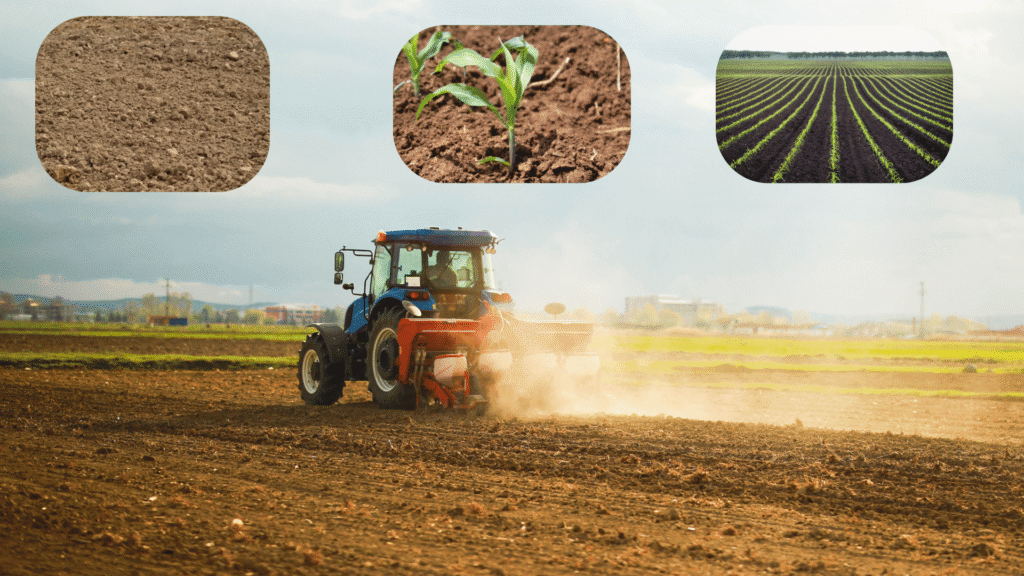
Table of Contents
ToggleIntroduction
Corn (maize) is one of the most important cereal crops in Pakistan and worldwide. Achieving a high yield in corn requires careful attention to soil preparation practices before sowing. Proper soil management improves seed germination, enhances root growth, increases nutrient availability, and minimizes weed pressure. In this article, we will explore the latest soil preparation practices for corn to get high yield, focusing on plowing, leveling, fertilization, moisture management, and modern technologies farmers can adopt.
Importance of Soil Preparation in Corn Cultivation
Soil preparation is the foundation of successful corn production. A well-prepared seedbed ensures:
Uniform germination and early crop establishment.
Adequate root penetration and nutrient uptake.
Better water retention and drainage.
Effective weed and pest control.
Studies show that 30–40% of corn yield potential depends on proper land and soil preparation. Therefore, adopting the latest soil preparation practices for corn is critical for maximizing profitability.
Field Selection and Previous Crop Residue Management
Before preparing the soil, farmers must select suitable fields for corn cultivation.
Soil type: Loamy, well-drained soils with good organic matter are best.
pH: Ideal soil pH for corn is between 5.8 and 7.0.
Previous crop residues: Remove or incorporate residues of wheat, rice, or sugarcane using rotavators or shredders. Incorporating residues adds organic matter but should be managed carefully to avoid nitrogen immobilization.
Primary Tillage – Plowing the Land
Primary tillage involves deep plowing to break compacted soil layers and improve aeration.
Disc plow or moldboard plow should be used to plow the land 6–8 inches deep.
Deep tillage reduces soil compaction, which is common in fields with continuous mechanization.
Farmers can also adopt chisel plowing once in 2–3 years to break the hardpan and improve water infiltration.
Secondary Tillage – Harrowing and Leveling
After primary tillage, secondary tillage helps create a fine seedbed.
Harrowing: Use disc harrows or tine cultivators 2–3 times to crush clods and mix crop residues evenly.
Leveling: Laser land leveling is one of the latest practices to improve uniform seed germination and water use efficiency. Studies indicate laser leveling increases corn yield by 10–15% due to better water distribution.
Organic Matter Addition
Maintaining soil organic matter is essential for high corn yields.
Farmyard manure (FYM): Apply 8–10 tons/acre before the last plowing.
Compost and green manure: Improve soil structure, microbial activity, and nutrient availability.
Biochar: Emerging as a modern soil amendment to enhance water retention and reduce nutrient leaching.
Organic matter addition is a sustainable soil preparation practice for corn, improving long-term soil fertility.
Fertilizer Application Before Sowing
Corn is a heavy feeder crop requiring balanced fertilization. Basal fertilizers should be incorporated during soil preparation.
Nitrogen (N): Apply one-third of total nitrogen before sowing.
Phosphorus (P2O5): Full dose (e.g., DAP or SSP) should be incorporated during seedbed preparation.
Potassium (K2O): Recommended full dose before sowing, especially in potassium-deficient soils.
Zinc sulfate (ZnSO4): Apply 10–12 kg/acre to prevent zinc deficiency in corn.
Moisture Management Before Planting
Corn requires adequate soil moisture at planting for uniform germination.
In rain-fed areas, sow immediately after rainfall to conserve soil moisture.
In irrigated zones, apply one pre-sowing irrigation (rauni irrigation) to soften the soil before plowing.
Avoid excess moisture that causes waterlogging and seed rotting.
Weed and Pest Control During Soil Preparation
Effective weed and pest control starts with proper soil preparation.
Pre-sowing weed management: Plowing destroys early weeds.
Stubble-burning alternatives: Instead of burning, use rotavators and shredders to incorporate residues, reducing pest habitats.
Termite control: Apply recommended insecticides (e.g., chlorpyrifos) with irrigation water in termite-infested soils.
Use of Cover Crops and Crop Rotation
Modern soil preparation practices emphasize sustainable approaches.
Growing legume cover crops before corn improves soil nitrogen.
Crop rotation with soybean, sunflower, or pulses helps reduce pest pressure and maintains soil fertility.
Cover crops such as clover also prevent soil erosion during off-season.
Modern Technologies in Soil Preparation for Corn
Recent technological advancements have revolutionized soil preparation:
Laser Land Leveling – Saves 25–30% irrigation water and ensures uniform germination.
Conservation Tillage – Minimum tillage with residue cover reduces soil erosion and conserves moisture.
Precision Agriculture Tools – GPS-guided seed drills ensure uniform row spacing and depth.
Soil Testing Kits – Enable farmers to adjust fertilizer applications according to soil nutrient status.
Precision agriculture and conservation tillage are part of modern sustainable soil management approaches recommended globally by experts such as FAO.
Final Seedbed Preparation and Sowing
A fine and firm seedbed is essential for proper seed placement.
Corn should be sown at a depth of 1.5–2 inches in loamy soils and 2–2.5 inches in sandy soils.
Plant spacing: 20–25 cm between plants and 60–75 cm between rows.
Use precision seeders to ensure uniform depth and spacing for higher yields.
Mistakes Farmers Should Avoid in Soil Preparation
Many farmers lose potential yield due to common soil preparation mistakes:
Shallow plowing leading to poor root growth.
Skipping land leveling, which causes uneven irrigation.
Overuse of chemical fertilizers without organic amendments.
Ignoring soil pH testing before applying inputs.
Impact of Soil Preparation on Corn Yield in Pakistan
A field trial in Punjab compared conventional vs. modern soil preparation practices for corn:
Conventional plowing: 75 maunds/acre yield.
Laser land leveling + organic matter + balanced fertilizers: 100 maunds/acre yield.
This shows that adopting the latest soil preparation practices for corn can increase yield by 25–30%.
Sustainable Soil Management for Future Corn Production
As agriculture faces challenges like climate change and soil degradation, sustainable soil practices are becoming crucial.
Integrating organic and inorganic inputs maintains long-term fertility.
Adopting conservation agriculture reduces fuel and labor costs.
Using soil moisture sensors ensures efficient irrigation scheduling.
These approaches not only improve yield but also enhance environmental sustainability.
Conclusion
Soil preparation is the backbone of successful corn production. By adopting the latest soil preparation practices for corn to get high yield—including proper plowing, leveling, organic matter addition, balanced fertilization, and modern technologies—farmers can maximize productivity and profitability. Sustainable soil management ensures that future generations continue to benefit from fertile, productive land.